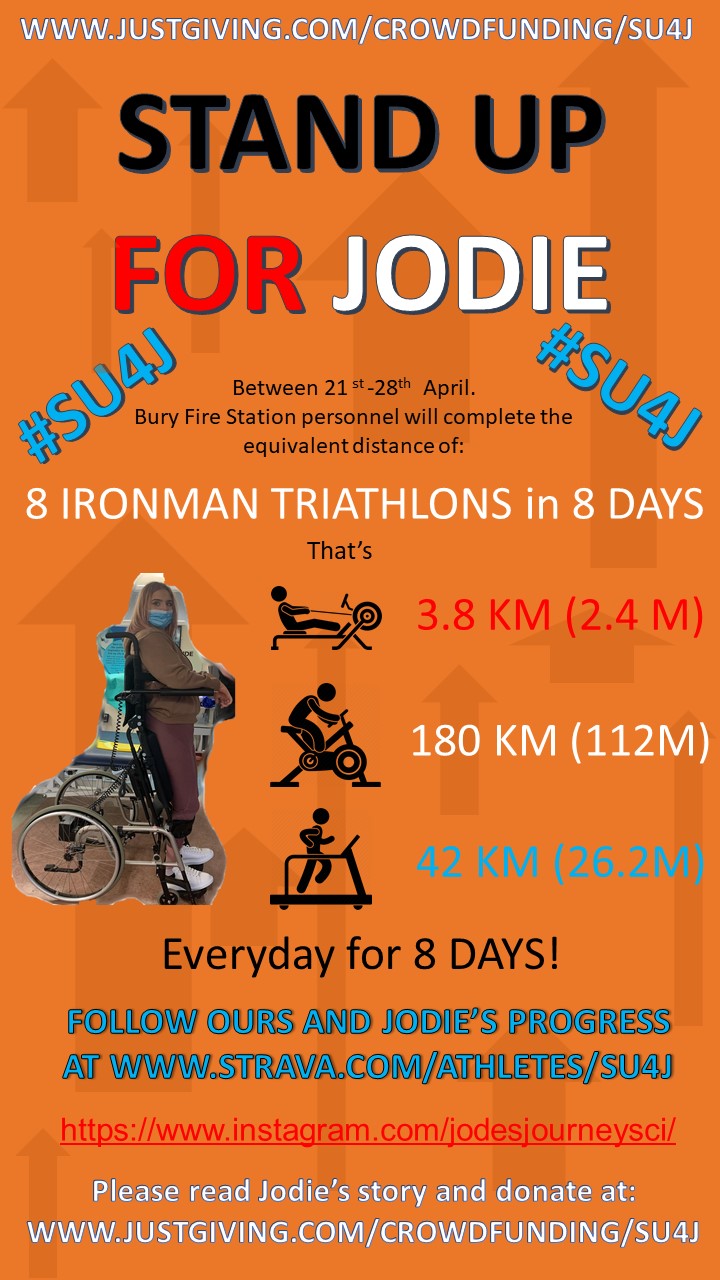Story
UPDATE: We smashed it! Thank you all so much. Jodie is ecstatic with the response.We are going to leave the page open until the challenge ends, any extra money raised will be put into trust for other equipment Jodie will need along the way.

Stand-up for Jodie Challenge #SU4J
The firefighters at Bury fire station are taking on the challenge of completing the equivalent of eight full iron man Triathlons over eight consecutive days. The challenge will take place between 21st and 28th April 2021.
Follow their progress on Strava at https://www.strava.com/athletes/su4j
Background
Jodie is the seventeen year old daughter of Greg & Helen Punshon. In June 2020 Jodie was out walking with a friend when she was involved in an accident where she sustained life changing injuries.
The Accident:
As the COVID-19 restrictions were beginning to be eased following the first national lockdown, Jodie arranged to meet up with a friend for a walk along the river path at Pot Green near to Ramsbottom. The walk ended abruptly in disaster as Jodie fell approximately six meters into the river below. Jodie has no memory of the incident and her friend did not see it happen, so the exact circumstances leading up to the fall are uncertain.
Jodie was rescued from the river and carried on a stretcher to the awaiting ambulance, by fire crews from Ramsbottom, Bury and Leigh (TRU). At this point Jodie was cared for by NWAS Paramedics and medical staff from the North west Air Ambulance before being transported by road to Salford Royal Hospital. Here she was stabilised in the A&E department before being transferred to the intensive care unit.
In the following hours the extent of Jodie’s injuries were discovered. Jodie had sustained a spinal fracture to her C6 vertebrae, this had compressed her spinal cord causing irreparable damage. After a few days in an induced coma Jodie had surgery to stabilise her fracture but nothing could be done about the damage to the spinal cord. It was at this time that the Doctors diagnosed tetraplegia as a result of the injury, this means that all four of her limbs are affected by loss of movement and feeling. Jodie has no movement or feeling below the top of her rib cage, she has regained some use of her arms but it is extremely unlikely that she will ever regain the use of her legs.
Jodie spent a month on ICU at Salford before being transferred to the North west regional spinal injury centre at Southport to begin her rehabilitation.
Jodie has an Instagram account where she has documented her recovery, you can follow her at
https://www.instagram.com/jodesjourneysci/
The Standing Wheelchair:

During her time at Southport Jodie discovered the benefits of being brought to a standing position. For people with spinal cord injuries, such as Jodie’s, this is something which is not easy to achieve. The option which best suits Jodie’s circumstances is a Standing wheelchair. This is like a standard manual chair but allows the user to independently bring themselves to the standing position by using an electric motor. The ability to stand on demand would mean that Jodie is able to be more independent, allowing her to do basic tasks such as accessing cupboards and standing at a kitchen worktop. Apart from the practical benefits there are also numerous physical health benefits, some of which are explained below.
All these benefits which most non-disabled people enjoy freely, unfortunately come at a cost for someone with Tetraplegia. The cost is around £10,000.
Increased Bone Density
The first couple of years after an SCI is when the bones degrade the most and get weaker, resulting in osteoporosis, which can cause fractures. Bearing weight (standing) can make leg bones stronger.
Improved Circulation
Not being able to move your legs causes bad circulation in them, which can result in blood clots. Standing can help circulate blood and maintain blood pressure, since the heart is pumping better.
Respiration Improves
When seated, the diaphragm has limited space. Standing gives the diaphragm more space to enlarge and shrink, which allows you to breathe in and out more effectively. This will help strengthen your lungs and allow you to cough to keep from being sick. Standing also helps you control your voice by making it stronger and louder.
It Promotes Skin Health
Since standing helps with respiration, standing lets more oxygenated blood reach areas that are prone to pressure when in the seated position. Standing is the ultimate pressure relief because it promotes skin health and helps prevent pressure sores.
Improved Bowel Function
Not being able to control your bowels voluntarily can be frustrating; especially when accidents happen. Standing improves bowel function and could eliminate accidents by activating stomach muscles and allowing gravity to help digestion.
Better Bladder Management
Urinary incontinence becomes an issue when you can’t control your bladder voluntarily. Standing improves bladder function and could help prevent leakage, UTI’s, and the need for bladder medication.
It Prevents Tight Muscles
Standing stretches your hamstrings, tendons, muscles, and heel cords. This results in less contractures, muscle spasms, and could help minimize the need for muscle relaxers or medication.
Increased Overall Wellbeing
Standing increases your mood, gives you more stamina and helps you sleep, allows for eye-to-eye level conversations so you’re not being looked down upon and you don’t have to look up, and adds to your ability to reach things.
Higher Quality of Life
Standing after an SCI enhances your quality of life by decreasing the risk of secondary complications, achieving the ability to stand, and increasing the level of function while standing.
Standing opens the internal cavity, which gives the internal organs more room.
No pills, no drugs, no surgery - just doing what your body is supposed to do.
Standing helps keep your body in good alignment, healthy, and strong.
Thankyou for reading Jodie's story and please help her if you can by donating whatever you can afford.
